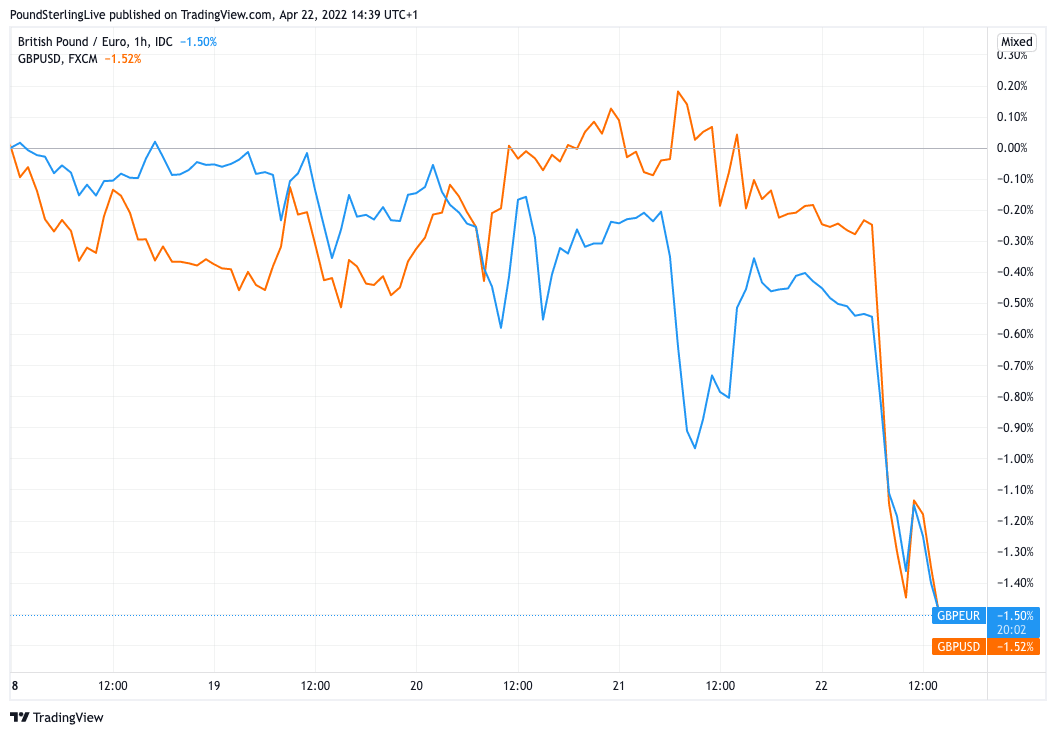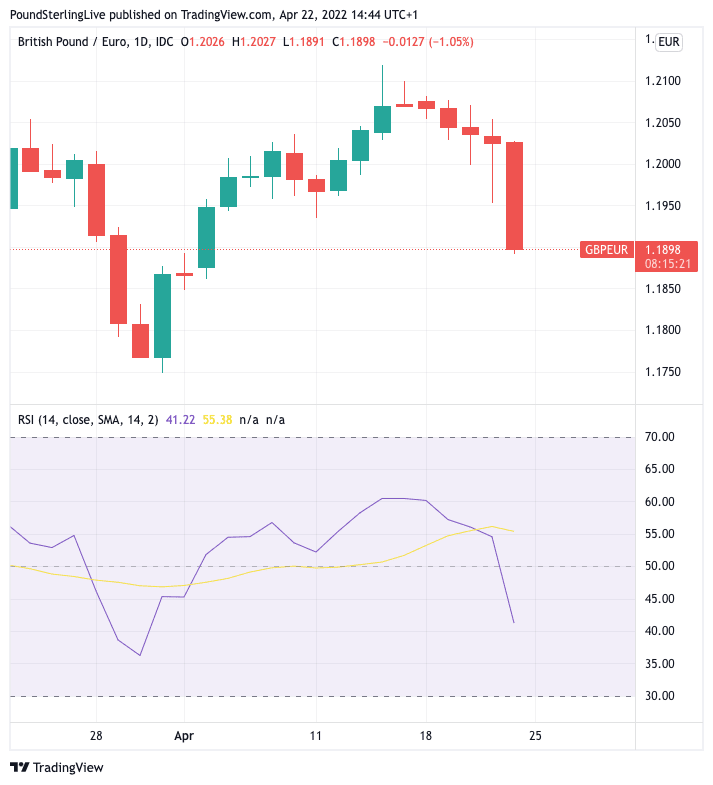Pound Sterling to Trend Lower against Euro & Dollar this Week: Saxo Bank
- Written by: Gary Howes
Saxo Bank says the bashing received by Pound Sterling last week leaves it ready to turn trend against the Euro and extend an already entrenched downtrend against the Dollar over coming days.
The British Pound fell sharply on Friday, extending a run of losses against the Euro and Dollar, following a string of underwhelming economic data releasees.
"Sterling took a nasty dive," says John Hardy, Saxo Bank’s Head of FX Strategy. "The market has likely over-estimated the BoE’s potential to hike rates this year".

Above: GBP vs. EUR (blue) and USD (orange) over the week starting April 18.
UK retail sales data undershot expectations massively while UK consumer confidence measured by GfK fell to within a whisker of all-time lows recorded around the time of the Great Financial Crisis in 2008.
The Pound fell by over a percent against the Euro, Dollar and other major currencies as markets reacted to signs of a looming significant slowdown in economic activity.
With signs that the UK economy is slowing markets are realising they have potentially been betting too excessively on the number of Bank of England interest rate rises likely in 2022.
The downshift in rate hike expectations has an inevitable mechanical downward pull on Pound exchange rates.
"GBP/USD burst down through 1.3000," says Hardy, "the next natural target is the psychological 1.2500 level, although the ultimate range support is 1.2000."
At the time of writing the Pound to Dollar exchange rate is at 1.2800, the Pound to Euro exchange rate is at 1.1880, giving a Euro-Pound rate of 0.8416.
Compare Currency Exchange Rates
Find out how much you could save on your international transfer
Estimated saving compared to high street banks:
£25.00
Free • No obligation • Takes 2 minutes
Hardy says the Euro-Pound exchange rate is "worth watching" as he believes there could be further upside over coming days.
Data from Saxo Bank reveals the trend in EUR/GBP has now shifted to neutral, having been negative for a long period of time.
Such a crossover in trend is significant in that it potentially calls time on Pound Sterling's recent period of gains against the Eurozone's single currency.
It could also open the door to further Sterling losses if EUR/GBP is in fact at the start of an uptrend.
EUR/GBP "could have legs next week," says Hardy.
There is further evidence of a turn in trend: the above chart shows the GBP/EUR at daily intervals with the Relative Strength Index (RSI) in the bottom pane.
The RSI is a measure of momentum and notably it has slid below 50 after the recent run of weakness.
At 41 it is comfortably in negative territory and is advocating for further declines in the Pound against the Euro. (Set your FX rate alert here).
A slew of disappointing economic data readings sent the British Pound sharply lower against the Euro and Dollar and other major currencies last Friday.
UK consumer confidence plummeted to levels last seen during the Great Financial Crisis of 2008, portending a potentially significant economic growth slowdown.
Retail sales for April meanwhile came in far below expectations, reading -1.4% month-on-month in March, far below the -0.3% markets expected and the -0.5% print of February.
S&P Global's PMI data for April - the most timely of surveys for the UK economy - showed a further slowing in growth rates as inflation surges.
"Downside risks for the pound are building with a host of specific negative developments providing reason for GBP sentiment to worsen over the coming days and weeks," says Derek Halpenny, Head of Research, Global Markets, at MUFG.
The Pound to Euro exchange rate slipped back below 1.20 again while the Pound to Dollar exchange rate fell below 1.29.
"Our main reason for caution on GBP is that we do not believe the Bank of England will be able to keep pace with the aggressive tightening cycle priced in by the rates market," says Dominic Bunning, Head of European FX Research at HSBC.
"The consumer and PMI data today adds to our scepticism while increasing political volatility - both at home and abroad - will not make life any easier for GBP," he adds.





